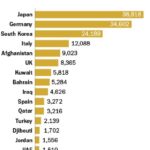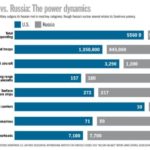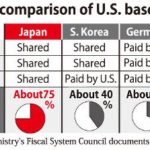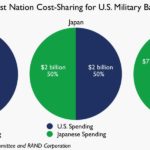There has been much talk lately about the United States removing military personnel from Germany, Japan and South Korea in an effort to save money.
In 2016, future President Trump said “They do not pay us. But they should be paying us, because we are providing tremendous service and we’re losing a fortune” SOURCE
In 2018, the Pentagon is analyzing the cost and impact of a large-scale withdrawal or transfer of American troops stationed in Germany, amid growing tensions between President Trump and German Chancellor Angela Merkel. SOURCE
The math on this is really quite simple. If the US military budget is not going to be cut as US troops are returned home and retired, there will be no cost saving. In fact, there will be a substantial increase in cost because currently countries like Germany and Japan pay for more than 25% of the soldiers wages and the cost of repatriating all that hardware will not be trivial.
If a notable decrease in US troops stationed oversees was matched with a US military budget decrease the math would be different, but in todays environment we just do not think that is likely.
Trump’s budget proposes historic increases for military… Trump is asking for a record $686 billion for the Pentagon, a 13% increase over the 2017 fiscal budget put in place last May. SOURCE
Here are some facts that may help you work through the logic yourself.
How Much Does Japan Pay For US Troops?
Japan covers $1.7B in direct US base payments and budgets about USD$4B in total US military (roads, electricity, water,…) SOURCE There are 49,000 US troops stationed in Japan.
The payments, which began in 1978 and are considered a pillar of the post-war U.S.-Japanese alliance, cover about a third or more of the cost of keeping 49,000 U.S. troops in Japan. …Japan has agreed to pay as much as $12 billion to build a new U.S. base on Okinawa for thousands of Marines now at the U.S. installation in the town of Futenma SOURCE
How Much Does South Korea Pay For US Troops?
South Korea pays the US more than $850 million a year for US Troops which is about 40% of the cost. SOURCE There are about 28,000 US military personnel stationed in South Korea
In 1966, Seoul agreed to provide “all facilities” …The most recent agreement, signed in 2014, increased South Korea’s contribution to more than $800 million a year. That’s equal to about half the annual cost of the 28,500 U.S. troops stationed there, according to Pentagon officials. …South Korea also is funding most of a $10.8-billion construction project that will allow U.S. troops to move from bases near Seoul and the Demilitarized Zone along the border with North Korea to new installations farther south SOURCE
How Much Does Germany Pay For US Troops?
Because Germany covers the cost of its 38,000 US Troops mostly through soft payments, it is difficult to calculate an exact number. However, low estimates claim Germany covers 18% of total cost and high estimates cover 30%. SOURCE1 SOURCE2
Germany plans to spend about $120 million to help offset the construction costs of several new U.S. schools for American military children in the country, and the locals aren’t pleased…German taxpayer support for U.S. bases comes at the cost of doing more for German schools he says are in disrepair. Some constituents are angry and want it to stop, … SOURCE
How Much Do Germany, Japan and South Korea Buy In US Military Equipment:
Michael P. Noonan, director of research and director of the Program on National Security for the Foreign Policy Research Institute, also pointed out that “all of those countries are big buyers of U.S. military equipment.” Military equipment and construction services sales delivered in 2014 totaled $526.8 million for Japan, $641 million for South Korea and $163.7 million for Germany SOURCE
Do US Military Personnel Make More Money When Stationed Overseas?
In a word, yes. US troops receive higher wages because of the higher cost of living in Japan, Germany and South Korea. Also there are moving costs and increased education costs for children. In 2014 the RAND corporation estimated that these costs total between $10,000 and $40,000 per person depending on the country of deployment and rank of the member. However, most of these differential costs are covered by the host country even though the US troops often work in the region as US interests dictate and not just within the host country. SOURCE
Summary
There is a solid argument for having host countries pay a large percentage of the cost to for US Troop deployments, but they already do. If you want to reduce costs by bring troops home, you will need to ensure there is a commensurate cut in the US military budget.
German, South Korean & Japanese US Military Spenging Graphic Gallery
Here are a few graphics we thought you might find interesting if you are researching this topic:








0 Comments